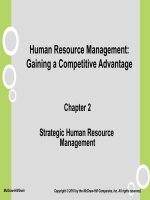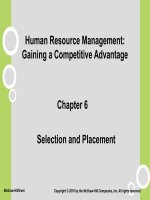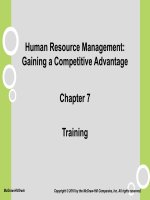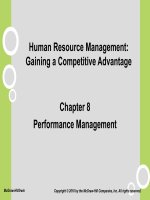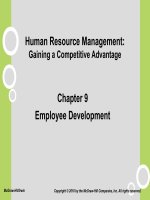HRM gaining a competitive advantage noe ch015
Bạn đang xem bản rút gọn của tài liệu. Xem và tải ngay bản đầy đủ của tài liệu tại đây (121.34 KB, 19 trang )
Human Resource Management:
Gaining a Competitive Advantage
Chapter 15
Managing Human Resources Globally
McGraw-Hill/Irwin
Copyright © 2010 by the McGraw-Hill Companies, Inc. All rights reserved.
Learning Objectives
Identify recent changes that have caused
companies to expand into international markets.
Discuss four factors that most strongly influence
HRM in international markets.
List different categories of international employees.
Identify four levels of global participation and HRM
issues faced within each level.
Discuss ways companies select, train, compensate
and reintegrate expatriate managers.
15-2
Introduction
Organizations function in a global economy.
International competition is #1 factor affecting
HRM.
International expansion can provide a
competitive advantage:
large numbers of potential customers.
low-cost labor
• Maquiladora plants
telecommunications and information technology
enables work to be done more rapidly, efficiently
and effectively around the globe.
15-3
Current Global Changes
European Economic Community
North American Free Trade Agreement (NAFTA)
Growth of Asia
Japan, China, Singapore, Hong Kong and
Malaysia are significant economic forces.
General Agreement on Tariffs and Trade (GATT)
15-4
Factors Affecting HRM
in International Markets
Culture
Education Human Capital
Human Resource
Management
Economic
System
PoliticalLegal
System
15-5
Hofstede’s Cultural Dimensions
1. Individualism/collectivism - degree to which
people act as individuals rather than as members
of a group.
1. Power distance - how a culture deals with
hierarchical power relationships.
2. Uncertainty avoidance - how cultures deal with
the fact that the future is not perfectly predictable.
1. Masculinity-femininity describes the division of
roles between the sexes within a society.
2. Long-term/short-term orientation - tendency of a
culture to focus on long-term benefit or short-term
outcomes.
15-6
Implications of Culture for HRM
1. Culture has an impact on approaches to managing.
2. Culture differs on how employees expect leaders
to lead, how decisions are handled within the
hierarchy and what motivates individuals.
3. Culture may influence appropriateness of HRM
practices.
4. Cultures can influence compensation systems and
communication and coordination processes.
5. Cultural diversity programs foster understanding
of other cultures to better communicate with them.
15-7
Education/Human Capital
Countries differ in their levels of human capital.
A country's human capital is determined by a
number of variables, primarily, educational
opportunity.
Countries with low human capital attract facilities
that require low skills and low-wage levels.
Countries with high human capital are attractive
sites for direct foreign investment that creates
high-skill jobs.
15-8
Political/Legal System
Dictates requirements of certain HRM practices,
such as training, compensation, hiring, firing and
layoffs.
Legal system is an outgrowth of the culture,
reflecting societal norms.
U. S. has led the world in eliminating discrimination in
the workplace and controlling the process of labor
management negotiations.
Germany has provided employees with a legal right
to "codetermination" in the workplace.
The EEC provides fundamental social rights of
workers: freedom of movement and freedom to
choose one's occupation and be fairly compensated.
15-9
Economic System
Under socialist economies, there is little
economic incentive to develop human
capital, but ample opportunity exists
because education is free.
In capitalist systems, the opposite situation
exists, with higher tuition at state
universities but economic incentives exist
through individual salaries.
Every country varies in terms of culture,
human capital and their legal, political and
economic systems.
15-10
Managing Employees in a Global Context
A parent country is the country in which the
company's corporate headquarters is
located.
A host country is the country in which the
parent country organization seeks to locate
(or has already located) a facility.
A third country is a country other than the
host country or parent country.
15-11
Types of International Employees
Expatriate - employee sent by a company in
one country to manage operations in a
different country. Three types of expatriates:
1. Parent-country nationals (PCNs) - employees
who were born and live in a parent country.
2. Host-country nationals (HCNs) - employees
who were born and raised in the host
country, as opposed to the parent country.
3. Third-country nationals (TCNs) - employees
born in a country other than the parent
country or host country but who work in the
host country.
15-12
Levels of Global Participation
Domestic
Global
Parent
Country
Host
Country
International
Cor p orate
headquar t ers
Cor p orate
headquar t ers
Multinational
Cor p orate
headquar t ers
Cor porate
headquart ers
Foreign
Foreign
Foreign
Foreign
subsidiar
y
subsidiar y
subsidiar y subsidiar y
Foreign
subsidiar y
Increasing Participation in Global Markets
15-13
Global Organizations
Global organizations compete on top-quality
products and services with lowest costs.
3 Attributes of Transnational HRM System:
1. Transnational scope - HR decisions must be
made from a global rather than a national or
regional perspective.
2. Transnational representation reflects the
multinational composition of a company's
managers.
3. Transnational process - extent to which the
company's planning and decision-making
processes include representatives and ideas
from a variety of cultures.
15-14
Selection of Expatriate Managers
Successful expatriates have technical
competence and ability to adjust to, and be
sensitive to, a new culture. Three
dimensions include:
1. Self
2. Relationship
3. Perception
Use of women in expatriate assignments has proven
beneficial for companies; men and women can perform
equally well.
15-15
Training and Development of Expatriates
Cross Cultural Training
Behavior in Meetings and Social Settings
Interpersonal and Communication Skills
Culture in the New Work Environment
15-16
Compensation of Expatriates
4 Components of Total Pay Packages:
1. Base Salary- annual salary, unadjusted.
2. Tax Equalization Allowances- payments for
higher tax rates of other countries.
3. Benefits- continuation of, or substitute for,
home benefits.
4. Allowances- cost-of-living, housing, education,
and relocation payments.
15-17
Reacculturation of Expatriates
Reentry may result in culture shock.
60 to 70 % of expatriates do not know what their
position will be upon their return.
25% leave the company within one year upon
returning.
Transition process necessitates communication
of corporate changes while the expatriate is
overseas and validation of the importance of the
expatriate's international work.
Training and rewards beyond salary and
benefits are key.
15-18
Summary
Companies competing globally require
top-quality people.
Many factors affect HRM in global
environment such as culture, human capital
and political, legal and economic systems.
Need to effectively manage HR, especially
regarding expatriates.
15-19

